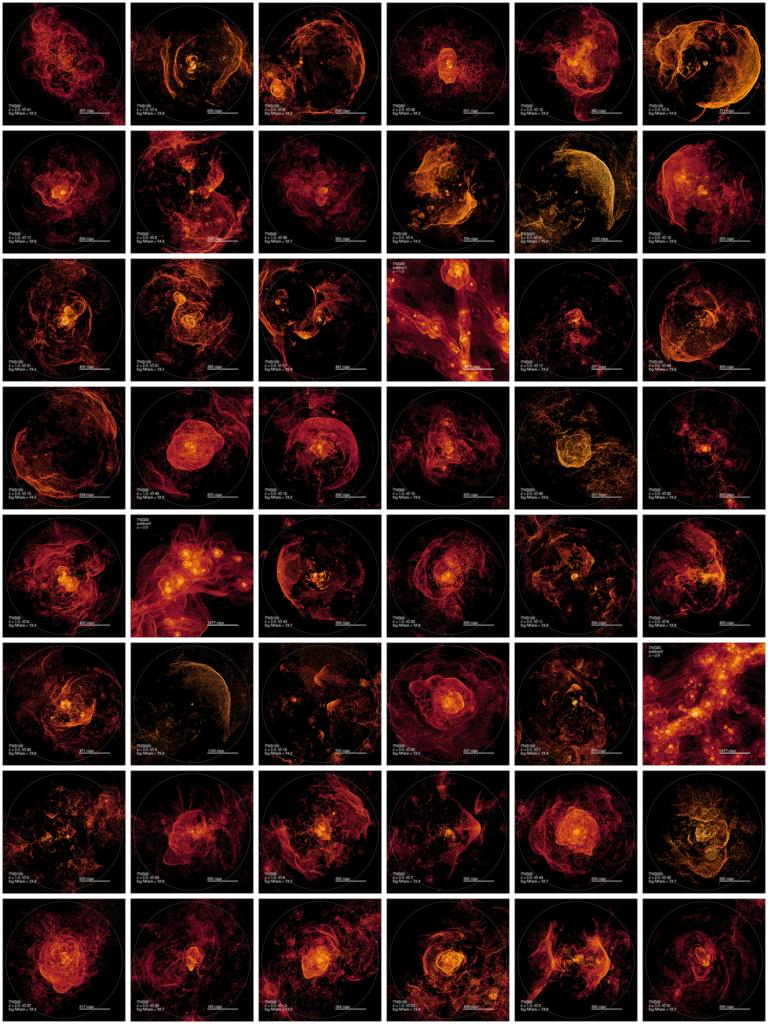Robust clustering predictions using hydrodynamics for different samples of galaxies
Not all matter in the universe is visible. The mass of matter that cannot be “seen” by direct observatops of its emitted or absorbed electromagnetic radiation is called dark matter. In the current lambda-Cold Dark Matter (ΛCDM) paradigm, the most accepted “theory to model the Universe in large scales”, so-called baryonic (visible) matter assembles where dark matter is denser. For this reason, it is expected that all visible galaxies reside embedded within a dark matter halo.
Today, it is accepted that the mass of the hosting halo correlates with the stellar mass of the galaxy located at its centre, with its size and with the total occupation of the halo. These and other correlations are nothing but a measurable manifestation of the multiple physical processes that take place inside halos, which shape the evolution of its baryonic content.
It follows that connecting the properties of galaxies to those of dark matter halos is a fundamental step in the extraction of cosmological information from measurements of galaxy clustering Besides, that connection is a necessary validation for theories of galaxy formation inside halos. One of the main methods to perform the aforementioned connection is the sub-halo abundance matching technique (SHAM).
In SHAM, galaxies from an observational (or synthetic) data set are linked to halos from an N-body numerical simulation by matching their number densities, assuming a one-to-one correspondence between primary halo and galaxy properties. For halos, either a halo mass or a velocity-related quantity (in their multiple forms) are assumed, on the basis that they are the main determinants of halo clustering. Analogously, either stellar mass or luminosity is chosen for the galaxy set, since they are easy to measure and are the properties that are known to correlate better with halo mass/velocity. To this simple prescription, a parametrized scatter in the halo-galaxy correspondence is added in order to account for the stochasticity in the way that galaxies populate haloes. The SHAM technique has been employed successfully in a number of clustering works accross different redshifts and for several galaxy populations.

The Illustris project was a series of astrophysical simulations run by an international collaboration of scientists. The aim was to study the processes of galaxy formation and evolution in the universe with a comprehensive physical model. IllustrisTNG is a successor to the original Illustris simulation. The simulations use a state of the art numerical code and a comprehensive physical model, which now incorporates magnetohydrodynamics, and runs on some of the largest supercomputers in the world.
Hydrodynamic simulations are laboratories for galaxy-formation physics which are ideal to test halo-galaxy linking techniques, since both the dark-matter and the baryonic components of halos are considered in detail. In this context, the recently released IllustrisTNG suite of hydrodynamic simulations offers some advantages, such as the large size of some of their boxes. IllustrisTNG has already shed light onto crucial aspects of the connection between galaxies and haloes.
Now, a team of researchers build on previous efforts and revisit the SHAM method using IllustrisTNG. 1
As a consequence of additional dependencies of galaxy and halo clustering being implemented into the SHAM formalism, a common picture is starting to emerge, where halo assembly bias (the secondary dependence on halo accretion history) might be intimately connected to environmental processes that take place in the cosmic web. In short, assembly bias might be the result of the truncation of accretion history in a population of smaller mass halos, which could be more likely in certain environments (i.e. filaments) than others (nodes). The researchers now model galaxy populations selected by colour and star-formation rate by including both secondary dependencies on halo and galaxy properties. They use the IllustrisTNG100 hydrodynamic simulation to test the SHAM performance in bins of stellar mass as a function of different galaxy and subhalo properties.
The scientists have overall found good agreement between their mocks and the TNG100 observations. Importantly, the accuracy of the clustering models obtained through secondary matching improves when the secondary subhalo and galactic properties are tightly correlated.
The enhanced SHAM presented in this work enables robust clustering predictions for different samples of red/blue and quenched/starforming galaxies. The model can be easily extended to match other galaxy/subhalo properties to achieve a more complete vision of the large-scale structure dynamics. Continuing the development of this new methodology is particularly relevant for next-generation surveys, such as DESI or Euclid, which will collect samples of hundreds of millions of galaxies at high redshift.
Author: César Tomé López is a science writer and the editor of Mapping Ignorance
Disclaimer: Parts of this article may have been copied verbatim or almost verbatim from the referenced research paper/s.
References
- Ginevra Favole, Antonio D Montero-Dorta, M Celeste Artale, Sergio Contreras, Idit Zehavi, Xiaoju Xu (2022) Subhalo abundance matching through the lens of a hydrodynamical simulation, Monthly Notices of the Royal Astronomical Society doi: 10.1093/mnras/stab3006 ↩